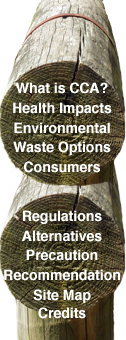What is CCA-Treated Timber?
![]() What
is CCA-treated timber?
What
is CCA-treated timber?![]() What
is CCA-treated timber used for?
What
is CCA-treated timber used for?![]() What
is the problem with CCA-treated timber?
What
is the problem with CCA-treated timber?![]() Is
Arsenic necessary to kill termites?
Is
Arsenic necessary to kill termites? ![]() Is
CCA-treated timber widely used in Australia?
Is
CCA-treated timber widely used in Australia?
What is CCA-treated timber?
CCA-treated timber is timber preserved with Copper Chrome Arsenate (CCA) or Chromated Copper Arsenate, as it is known in some countries. The copper (23-25%) and arsenic (30-37%) in CCA act as fungicides and insecticides, while the chromium (38-45%) fixes the chemicals into the wood (APVMA, 2003e; Greaves 2003). The chemical mixture is injected into the wood under pressure so that the wood is saturated with the chemicals.
What is CCA-treated timber used for?
Wood, such as radiata pine, is treated with CCA to prolong its life. CCA is used for the ‘control and prevention of damage to timber and timber structures by insects, wood rot, wood fungus and general timber decay. CCA is generally used on wood intended for outdoor uses, such as telegraph poles, decking and fencing, in landscaping, and in building structures’ (APVMA, 2003a). It is also commonly used in playgrounds, children's cubby houses, public picnic tables, garden edgings, handrails, boat bulkheads, dock pilings and vineyard stakes. CCA-treated timber can often be identified when it is new by its green tinge but this fades with time.
According to the CSIRO, ‘preservation allows about $500 million dollars worth of timber to be used in Australia in areas and applications where it would otherwise be unsuitable’ (CSIRO, 2003).
What is the problem with CCA-treated timber?
There is a growing body of scientific evidence that timber treated with CCA poses a danger to both humans and the environment. As a result, authorities around the world are imposing tighter restrictions on its manufacture, use and disposal.
Of greatest concern is the seepage of arsenic, a known human carcinogen, onto the surfaces of CCA-treated timber from where it can be dislodged onto hands and washed off into nearby soil or surrounding water. Chromium is also a human carcinogen. However, there is a lack of health studies on the combined health impact of copper, chromium and arsenic.
Is Arsenic necessary to kill termites?
Recently, CSIRO research has determined that copper chromate is sufficient to control termite activity, and that the major advantage of having arsenic in CCA is to control copper-tolerant fungi (CSIRO, 2005). This raises questions regarding whether continued use of arsenic can be justified, considering the documented health and environmental impacts.
Is CCA-treated timber widely used in Australia?
CCA-treated timber is ubiquitous in Australian homes, playgrounds and public spaces, and residential and commercial structures.
Australia is a major international manufacturer of CCA-treated timber, and the high sales each year ensure this product is cost competitive with any alternative-treated timber or other material. Koppers Arch, one of the largest manufacturers of CCA-treated wood, estimates that up to 1 million cubic metres of CCA-treated timber is used in Australia each year (cited in Rouse, 2004) or 6500 tonnes per year, according to the Waste Management Association of Australia (Bell, 2005).
CCA is also widely used in the US (Sharp and Walker, 2001). Australia, New Zealand and the US are the three largest per capita users of treated timber in the world (Greaves, 2003).
References:
APVMA (2003a), The Reconsideration Of Registrations Of Arsenic Timber Treatment Products (CCA And Arsenic Trioxide) And Their Associated Labels (Review Summary), Australian Pesticides And Veterinary Medicines Authority, Canberra. (pdf - 1.2MB)
APVMA (2003e) Arsenic Timber Treatments (CCA and Arsenic Trioxide): Review Scope Document. Canberra: Australian Pesticides and Veterinary Medicines Authority, Canberra, March. (pdf-160kb)
Bell, F. (2005), ‘Managing Treated Timber Vine Posts’, paper present to 3rd Australian Wine Industry Environment Conference, Adelaide, February.
CSIRO (2003), ‘Wood Protection’, Commonwealth Scientific and Industrial Research Organisation website, http://www.ffp.csiro.au/wft/wpc (accessed 21/4/04).
CSIRO (2005), ‘Safety of timber treated with CCA preservative’, Commonwealth Scientific and Industrial Research Organisation- Forestry and Forest Products website, http://www.ffp.csiro.au/wft/wpc/ccafact1.html (accessed 23/2/05).
Greaves, H. (2003), The Australian Timber Industry and CCA-Treated Timber Products, The Timber Preservers Association of Australia (TPAA), Moorabbin, Vic., 3 March. (pdf - 280kb)
Rouse, A. (2004), ‘WWF Submission on the Draft for draft Australian Standard (DR 03476 – 3481): Guide to the Safe Use of Preservative-Treated Timber’, Worldwide Fund for Nature (Australia), February 18.
Sharp, R. and Walker, B. (2001), Poisoned Playgrounds: Arsenic in 'Pressure-Treated' Wood, Environmental Working Group and Healthy Building Network, Washington D.C. http://www.ewg.org/reports/poisonedplaygrounds


